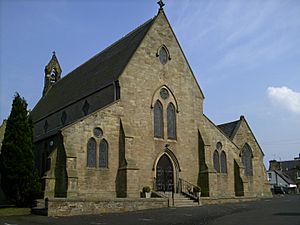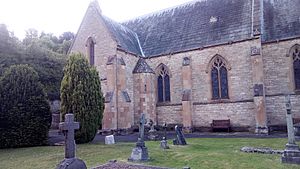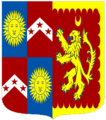Cecil Chetwynd Kerr, Marchioness of Lothian facts for kids
Quick facts for kids
Cecil Kerr
|
|
|---|---|
| Marchioness of Lothian | |
 |
|
| Born | 17 April 1808 Ingestre Hall, Staffordshire |
| Died | 13 May 1877 (aged 69) Rome, Italy |
| Spouse(s) | John Kerr, 7th Marquess of Lothian |
| Issue | 7 |
| Father | Charles Chetwynd-Talbot, 2nd Earl Talbot |
| Mother | Frances Thomasine |
Cecil Chetwynd Kerr (born Lady Cecil Chetwynd-Talbot; 17 April 1808 – 13 May 1877) was an important British lady who helped many people. She was known as the Marchioness of Lothian. Cecil founded two churches: Saint John's Church in Jedburgh and Saint David's Church in Dalkeith. She was very religious and changed her faith from Anglicanism to Roman Catholicism later in life.
Contents
A Life of Faith and Giving
Early Life and Family
Cecil Kerr was born on 17 April 1808 at Ingestre Hall in Staffordshire, England. She was one of twelve children. Her parents were Frances Thomasine and Charles Chetwynd-Talbot, 2nd Earl Talbot. Cecil was the sixth child in her large family. Sadly, her mother passed away shortly after her youngest sibling was born. Her father made sure Cecil received a good education. He also taught her a lot about their religion.
Marriage and New Home
On 12 July 1831, Cecil married John Kerr, 7th Marquess of Lothian. After their wedding, she moved to Scotland to live with her husband. Her favorite home was Monteviot House, which was close to Jedburgh. The main family home was Newbattle Abbey. In 1840, she moved to Monteviot so she could attend her local Scottish Episcopal Church in Kelso.
Finding Her Faith
Cecil and John had seven children together. In 1841, her husband passed away at another family estate. After this, Cecil became very interested in a religious movement called the Oxford Movement. This group believed that the Anglican Church should bring back some older practices from Roman Catholicism. Their followers were sometimes called Tractarianists. Cecil's spiritual guide, John Henry Newman, was a main leader in this group.
Cecil used her own money to build an Anglican church called St John's in Jedburgh. It was very close to her home at Monteviot. The church was officially opened on 15 August 1843. The opening was a big event with special speakers and a choir. It included services that lasted for several days.
Two years later, in 1845, John Henry Newman became a Roman Catholic. In 1851, Cecil also decided to convert to Catholicism. She was guided by another important religious leader, Henry Edward Manning.
Helping Others
Cecil continued her good work even when she was in London. She became friends with other important Catholic women. These included the writer Georgiana Fullerton and Margaret, Countess of Newburgh. Both of these women had also converted to Catholicism.
Being Catholic at that time could be difficult in Britain. There were laws that treated Catholics differently. Cecil was one of the guardians for her children. The other guardians were worried she might try to convert her children to Catholicism. To protect her children's faith, Cecil secretly took them to Edinburgh. There, they were welcomed into the Roman Catholic Church. Her oldest son was away at Oxford University and remained Anglican.

Cecil built a new Roman Catholic church in Dalkeith, Scotland. This church, St. David's, is now a protected historic building. She also became friends with Charlotte Montagu Douglas Scott, Duchess of Buccleuch. Charlotte later converted to Catholicism in 1860. Cecil and Charlotte worked together to support charity projects in Edinburgh. Cecil's daughter, also named Cecil, became a nun.
Cecil Kerr often traveled to Rome. She passed away there in 1877. However, she was buried in her own church in Dalkeith, right at the foot of the altar. Her son Walter had commissioned the altar that same year.
Images for kids




